Legal Analysis: Consumer Law, Civil Liability, and Defenses
VerifiedAdded on 2023/06/08
|7
|1986
|166
Homework Assignment
AI Summary
This assignment analyzes two scenarios under Australian law. The first scenario examines Rachel's right to a refund for a dress under the Australian Consumer Law, focusing on whether she is entitled to a refund after changing her mind, and the store's defenses. The second scenario assesses Beth's potential defense against a negligence claim brought by Charlie, who was injured during a water rafting trip. It explores the applicability of the Civil Liability Act 2003, particularly the concepts of voluntary assumption of risk and informed consent. The assignment highlights the importance of consumer rights, the responsibilities of businesses, and the legal frameworks governing liability and negligence.

Individual project
Paraphrase This Document
Need a fresh take? Get an instant paraphrase of this document with our AI Paraphraser
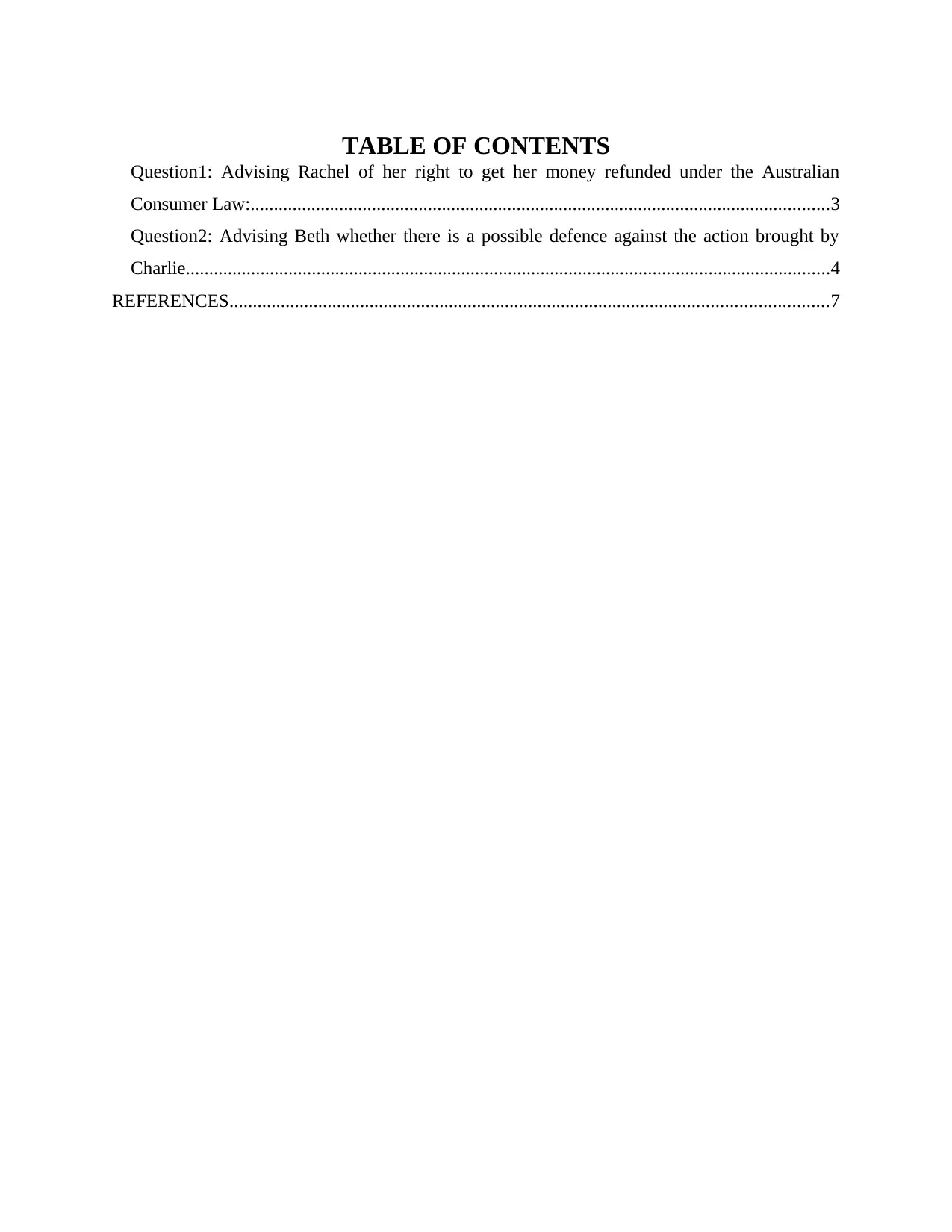
TABLE OF CONTENTS
Question1: Advising Rachel of her right to get her money refunded under the Australian
Consumer Law:............................................................................................................................3
Question2: Advising Beth whether there is a possible defence against the action brought by
Charlie..........................................................................................................................................4
REFERENCES................................................................................................................................7
Question1: Advising Rachel of her right to get her money refunded under the Australian
Consumer Law:............................................................................................................................3
Question2: Advising Beth whether there is a possible defence against the action brought by
Charlie..........................................................................................................................................4
REFERENCES................................................................................................................................7
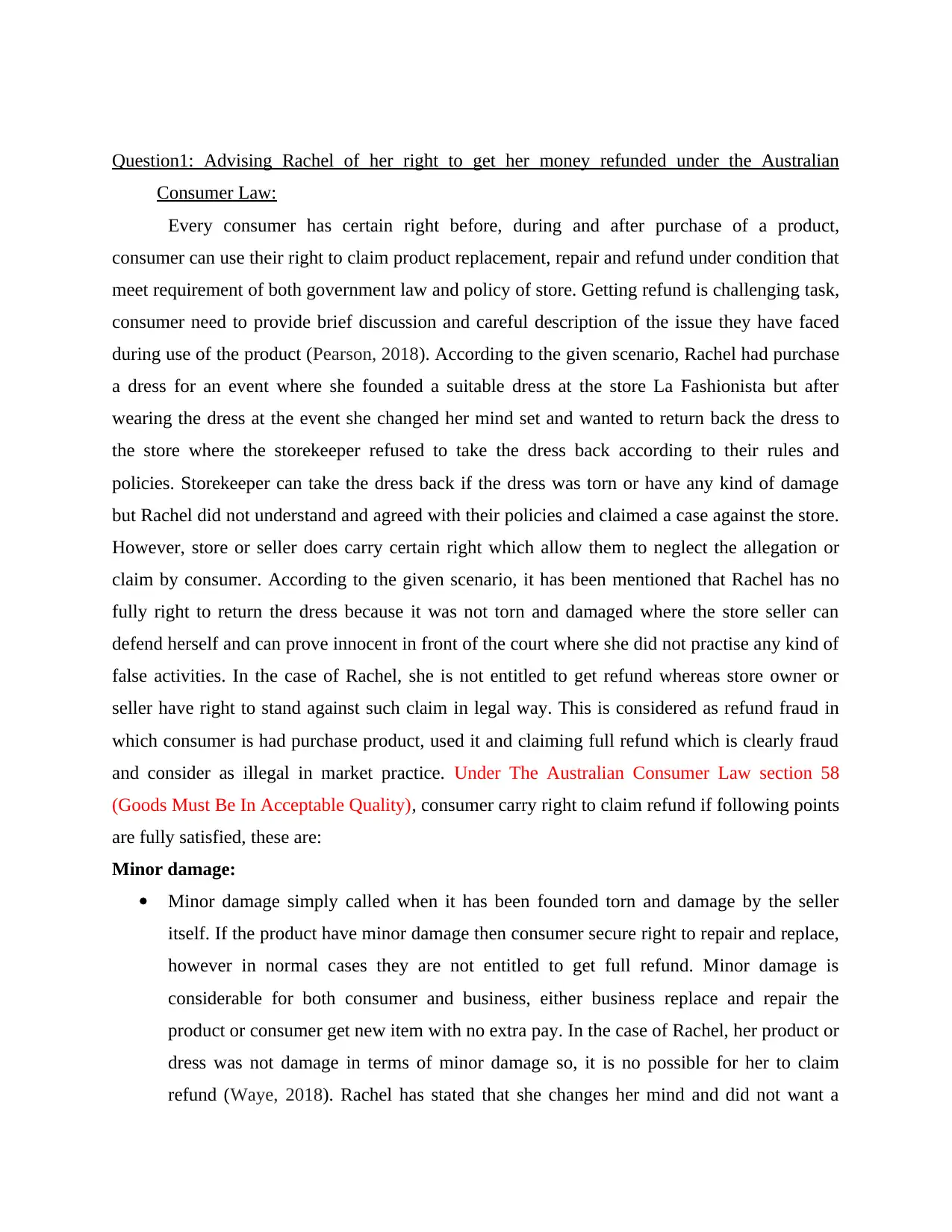
Question1: Advising Rachel of her right to get her money refunded under the Australian
Consumer Law:
Every consumer has certain right before, during and after purchase of a product,
consumer can use their right to claim product replacement, repair and refund under condition that
meet requirement of both government law and policy of store. Getting refund is challenging task,
consumer need to provide brief discussion and careful description of the issue they have faced
during use of the product (Pearson, 2018). According to the given scenario, Rachel had purchase
a dress for an event where she founded a suitable dress at the store La Fashionista but after
wearing the dress at the event she changed her mind set and wanted to return back the dress to
the store where the storekeeper refused to take the dress back according to their rules and
policies. Storekeeper can take the dress back if the dress was torn or have any kind of damage
but Rachel did not understand and agreed with their policies and claimed a case against the store.
However, store or seller does carry certain right which allow them to neglect the allegation or
claim by consumer. According to the given scenario, it has been mentioned that Rachel has no
fully right to return the dress because it was not torn and damaged where the store seller can
defend herself and can prove innocent in front of the court where she did not practise any kind of
false activities. In the case of Rachel, she is not entitled to get refund whereas store owner or
seller have right to stand against such claim in legal way. This is considered as refund fraud in
which consumer is had purchase product, used it and claiming full refund which is clearly fraud
and consider as illegal in market practice. Under The Australian Consumer Law section 58
(Goods Must Be In Acceptable Quality), consumer carry right to claim refund if following points
are fully satisfied, these are:
Minor damage:
Minor damage simply called when it has been founded torn and damage by the seller
itself. If the product have minor damage then consumer secure right to repair and replace,
however in normal cases they are not entitled to get full refund. Minor damage is
considerable for both consumer and business, either business replace and repair the
product or consumer get new item with no extra pay. In the case of Rachel, her product or
dress was not damage in terms of minor damage so, it is no possible for her to claim
refund (Waye, 2018). Rachel has stated that she changes her mind and did not want a
Consumer Law:
Every consumer has certain right before, during and after purchase of a product,
consumer can use their right to claim product replacement, repair and refund under condition that
meet requirement of both government law and policy of store. Getting refund is challenging task,
consumer need to provide brief discussion and careful description of the issue they have faced
during use of the product (Pearson, 2018). According to the given scenario, Rachel had purchase
a dress for an event where she founded a suitable dress at the store La Fashionista but after
wearing the dress at the event she changed her mind set and wanted to return back the dress to
the store where the storekeeper refused to take the dress back according to their rules and
policies. Storekeeper can take the dress back if the dress was torn or have any kind of damage
but Rachel did not understand and agreed with their policies and claimed a case against the store.
However, store or seller does carry certain right which allow them to neglect the allegation or
claim by consumer. According to the given scenario, it has been mentioned that Rachel has no
fully right to return the dress because it was not torn and damaged where the store seller can
defend herself and can prove innocent in front of the court where she did not practise any kind of
false activities. In the case of Rachel, she is not entitled to get refund whereas store owner or
seller have right to stand against such claim in legal way. This is considered as refund fraud in
which consumer is had purchase product, used it and claiming full refund which is clearly fraud
and consider as illegal in market practice. Under The Australian Consumer Law section 58
(Goods Must Be In Acceptable Quality), consumer carry right to claim refund if following points
are fully satisfied, these are:
Minor damage:
Minor damage simply called when it has been founded torn and damage by the seller
itself. If the product have minor damage then consumer secure right to repair and replace,
however in normal cases they are not entitled to get full refund. Minor damage is
considerable for both consumer and business, either business replace and repair the
product or consumer get new item with no extra pay. In the case of Rachel, her product or
dress was not damage in terms of minor damage so, it is no possible for her to claim
refund (Waye, 2018). Rachel has stated that she changes her mind and did not want a
⊘ This is a preview!⊘
Do you want full access?
Subscribe today to unlock all pages.

Trusted by 1+ million students worldwide
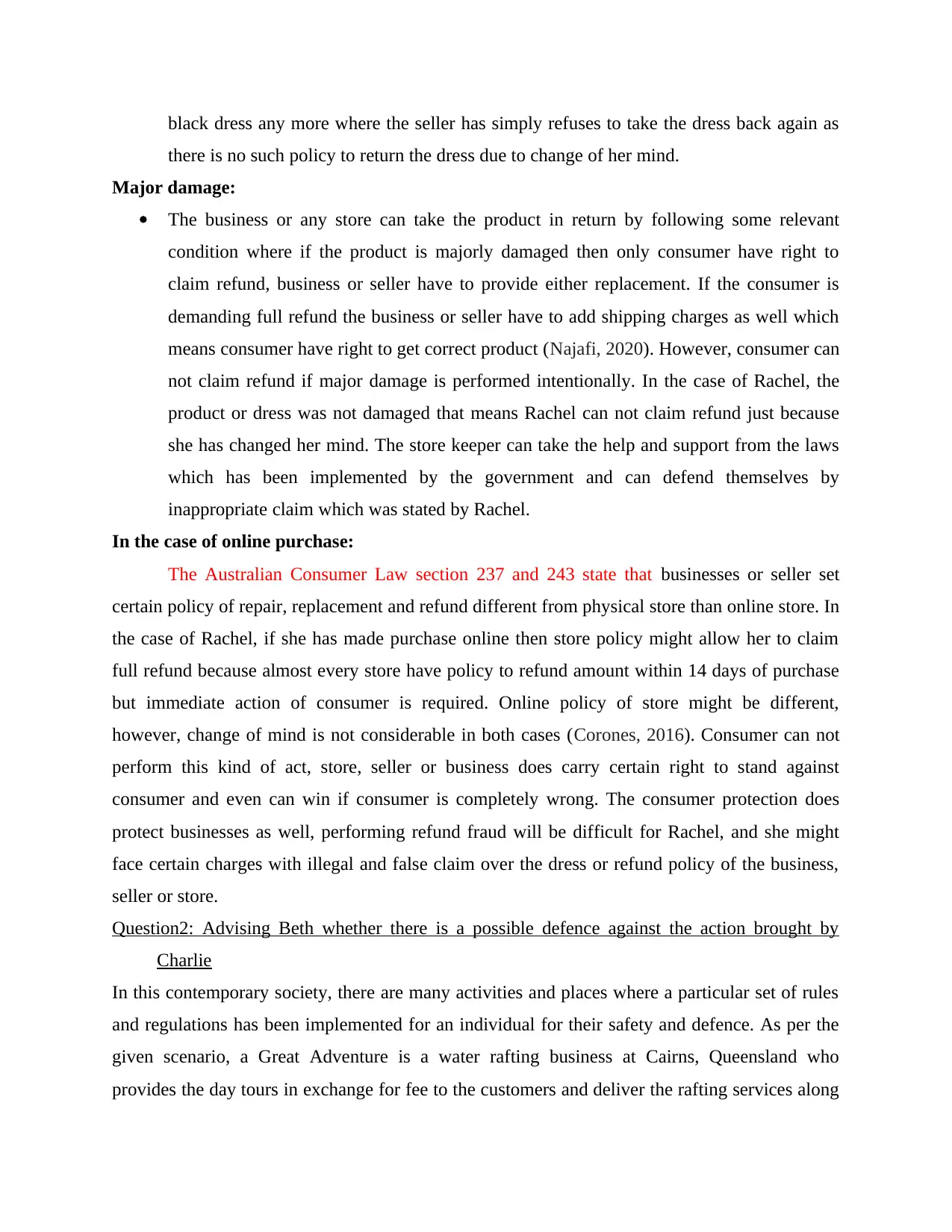
black dress any more where the seller has simply refuses to take the dress back again as
there is no such policy to return the dress due to change of her mind.
Major damage:
The business or any store can take the product in return by following some relevant
condition where if the product is majorly damaged then only consumer have right to
claim refund, business or seller have to provide either replacement. If the consumer is
demanding full refund the business or seller have to add shipping charges as well which
means consumer have right to get correct product (Najafi, 2020). However, consumer can
not claim refund if major damage is performed intentionally. In the case of Rachel, the
product or dress was not damaged that means Rachel can not claim refund just because
she has changed her mind. The store keeper can take the help and support from the laws
which has been implemented by the government and can defend themselves by
inappropriate claim which was stated by Rachel.
In the case of online purchase:
The Australian Consumer Law section 237 and 243 state that businesses or seller set
certain policy of repair, replacement and refund different from physical store than online store. In
the case of Rachel, if she has made purchase online then store policy might allow her to claim
full refund because almost every store have policy to refund amount within 14 days of purchase
but immediate action of consumer is required. Online policy of store might be different,
however, change of mind is not considerable in both cases (Corones, 2016). Consumer can not
perform this kind of act, store, seller or business does carry certain right to stand against
consumer and even can win if consumer is completely wrong. The consumer protection does
protect businesses as well, performing refund fraud will be difficult for Rachel, and she might
face certain charges with illegal and false claim over the dress or refund policy of the business,
seller or store.
Question2: Advising Beth whether there is a possible defence against the action brought by
Charlie
In this contemporary society, there are many activities and places where a particular set of rules
and regulations has been implemented for an individual for their safety and defence. As per the
given scenario, a Great Adventure is a water rafting business at Cairns, Queensland who
provides the day tours in exchange for fee to the customers and deliver the rafting services along
there is no such policy to return the dress due to change of her mind.
Major damage:
The business or any store can take the product in return by following some relevant
condition where if the product is majorly damaged then only consumer have right to
claim refund, business or seller have to provide either replacement. If the consumer is
demanding full refund the business or seller have to add shipping charges as well which
means consumer have right to get correct product (Najafi, 2020). However, consumer can
not claim refund if major damage is performed intentionally. In the case of Rachel, the
product or dress was not damaged that means Rachel can not claim refund just because
she has changed her mind. The store keeper can take the help and support from the laws
which has been implemented by the government and can defend themselves by
inappropriate claim which was stated by Rachel.
In the case of online purchase:
The Australian Consumer Law section 237 and 243 state that businesses or seller set
certain policy of repair, replacement and refund different from physical store than online store. In
the case of Rachel, if she has made purchase online then store policy might allow her to claim
full refund because almost every store have policy to refund amount within 14 days of purchase
but immediate action of consumer is required. Online policy of store might be different,
however, change of mind is not considerable in both cases (Corones, 2016). Consumer can not
perform this kind of act, store, seller or business does carry certain right to stand against
consumer and even can win if consumer is completely wrong. The consumer protection does
protect businesses as well, performing refund fraud will be difficult for Rachel, and she might
face certain charges with illegal and false claim over the dress or refund policy of the business,
seller or store.
Question2: Advising Beth whether there is a possible defence against the action brought by
Charlie
In this contemporary society, there are many activities and places where a particular set of rules
and regulations has been implemented for an individual for their safety and defence. As per the
given scenario, a Great Adventure is a water rafting business at Cairns, Queensland who
provides the day tours in exchange for fee to the customers and deliver the rafting services along
Paraphrase This Document
Need a fresh take? Get an instant paraphrase of this document with our AI Paraphraser
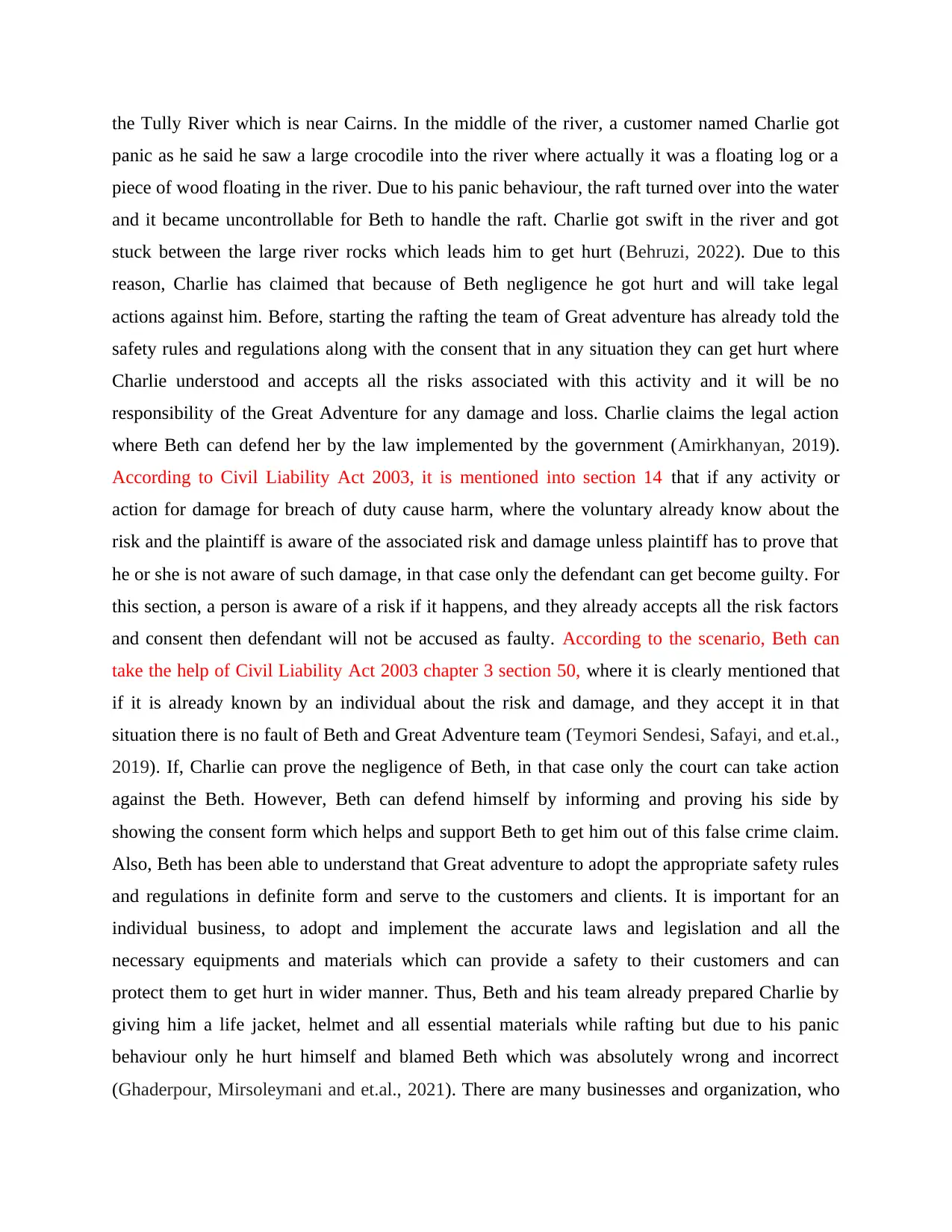
the Tully River which is near Cairns. In the middle of the river, a customer named Charlie got
panic as he said he saw a large crocodile into the river where actually it was a floating log or a
piece of wood floating in the river. Due to his panic behaviour, the raft turned over into the water
and it became uncontrollable for Beth to handle the raft. Charlie got swift in the river and got
stuck between the large river rocks which leads him to get hurt (Behruzi, 2022). Due to this
reason, Charlie has claimed that because of Beth negligence he got hurt and will take legal
actions against him. Before, starting the rafting the team of Great adventure has already told the
safety rules and regulations along with the consent that in any situation they can get hurt where
Charlie understood and accepts all the risks associated with this activity and it will be no
responsibility of the Great Adventure for any damage and loss. Charlie claims the legal action
where Beth can defend her by the law implemented by the government (Amirkhanyan, 2019).
According to Civil Liability Act 2003, it is mentioned into section 14 that if any activity or
action for damage for breach of duty cause harm, where the voluntary already know about the
risk and the plaintiff is aware of the associated risk and damage unless plaintiff has to prove that
he or she is not aware of such damage, in that case only the defendant can get become guilty. For
this section, a person is aware of a risk if it happens, and they already accepts all the risk factors
and consent then defendant will not be accused as faulty. According to the scenario, Beth can
take the help of Civil Liability Act 2003 chapter 3 section 50, where it is clearly mentioned that
if it is already known by an individual about the risk and damage, and they accept it in that
situation there is no fault of Beth and Great Adventure team (Teymori Sendesi, Safayi, and et.al.,
2019). If, Charlie can prove the negligence of Beth, in that case only the court can take action
against the Beth. However, Beth can defend himself by informing and proving his side by
showing the consent form which helps and support Beth to get him out of this false crime claim.
Also, Beth has been able to understand that Great adventure to adopt the appropriate safety rules
and regulations in definite form and serve to the customers and clients. It is important for an
individual business, to adopt and implement the accurate laws and legislation and all the
necessary equipments and materials which can provide a safety to their customers and can
protect them to get hurt in wider manner. Thus, Beth and his team already prepared Charlie by
giving him a life jacket, helmet and all essential materials while rafting but due to his panic
behaviour only he hurt himself and blamed Beth which was absolutely wrong and incorrect
(Ghaderpour, Mirsoleymani and et.al., 2021). There are many businesses and organization, who
panic as he said he saw a large crocodile into the river where actually it was a floating log or a
piece of wood floating in the river. Due to his panic behaviour, the raft turned over into the water
and it became uncontrollable for Beth to handle the raft. Charlie got swift in the river and got
stuck between the large river rocks which leads him to get hurt (Behruzi, 2022). Due to this
reason, Charlie has claimed that because of Beth negligence he got hurt and will take legal
actions against him. Before, starting the rafting the team of Great adventure has already told the
safety rules and regulations along with the consent that in any situation they can get hurt where
Charlie understood and accepts all the risks associated with this activity and it will be no
responsibility of the Great Adventure for any damage and loss. Charlie claims the legal action
where Beth can defend her by the law implemented by the government (Amirkhanyan, 2019).
According to Civil Liability Act 2003, it is mentioned into section 14 that if any activity or
action for damage for breach of duty cause harm, where the voluntary already know about the
risk and the plaintiff is aware of the associated risk and damage unless plaintiff has to prove that
he or she is not aware of such damage, in that case only the defendant can get become guilty. For
this section, a person is aware of a risk if it happens, and they already accepts all the risk factors
and consent then defendant will not be accused as faulty. According to the scenario, Beth can
take the help of Civil Liability Act 2003 chapter 3 section 50, where it is clearly mentioned that
if it is already known by an individual about the risk and damage, and they accept it in that
situation there is no fault of Beth and Great Adventure team (Teymori Sendesi, Safayi, and et.al.,
2019). If, Charlie can prove the negligence of Beth, in that case only the court can take action
against the Beth. However, Beth can defend himself by informing and proving his side by
showing the consent form which helps and support Beth to get him out of this false crime claim.
Also, Beth has been able to understand that Great adventure to adopt the appropriate safety rules
and regulations in definite form and serve to the customers and clients. It is important for an
individual business, to adopt and implement the accurate laws and legislation and all the
necessary equipments and materials which can provide a safety to their customers and can
protect them to get hurt in wider manner. Thus, Beth and his team already prepared Charlie by
giving him a life jacket, helmet and all essential materials while rafting but due to his panic
behaviour only he hurt himself and blamed Beth which was absolutely wrong and incorrect
(Ghaderpour, Mirsoleymani and et.al., 2021). There are many businesses and organization, who
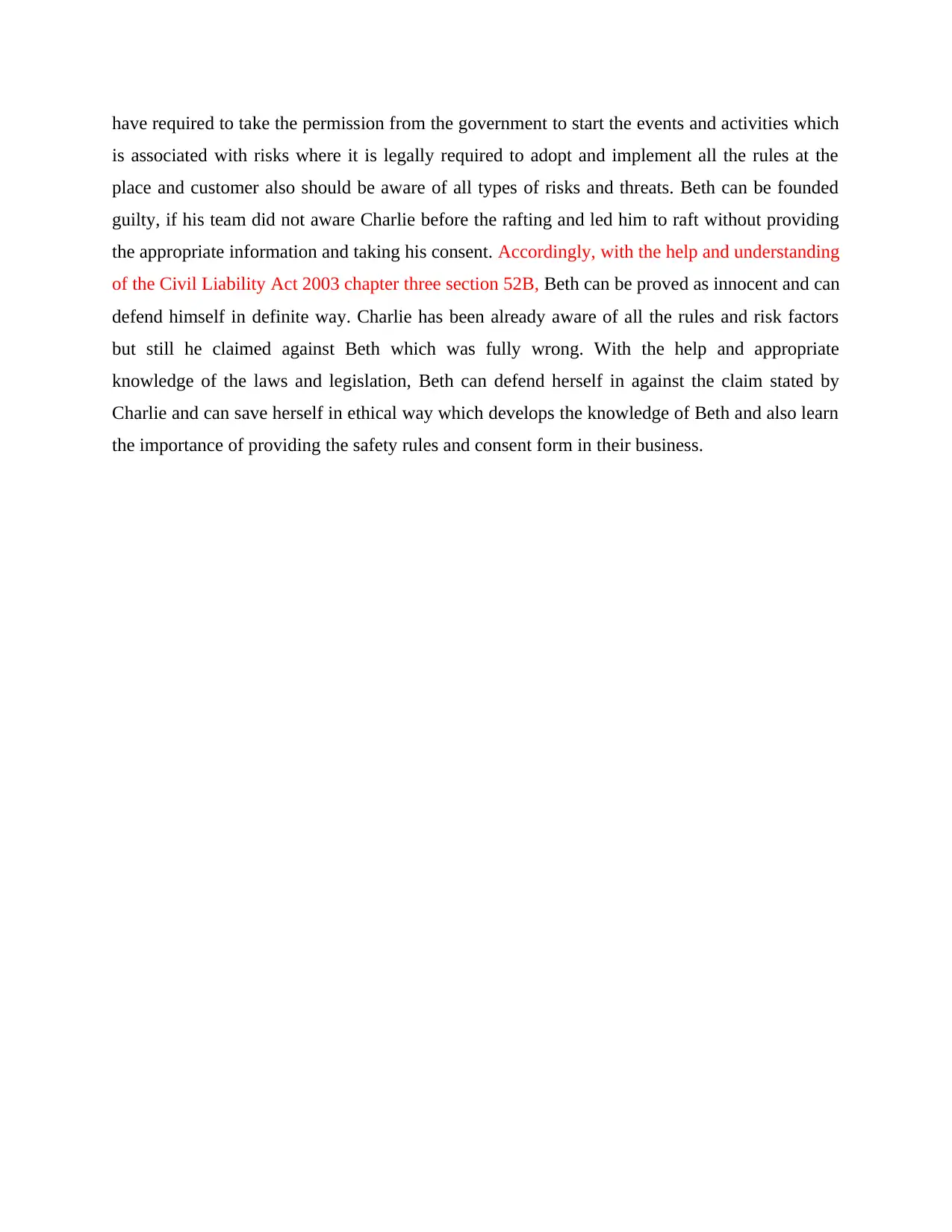
have required to take the permission from the government to start the events and activities which
is associated with risks where it is legally required to adopt and implement all the rules at the
place and customer also should be aware of all types of risks and threats. Beth can be founded
guilty, if his team did not aware Charlie before the rafting and led him to raft without providing
the appropriate information and taking his consent. Accordingly, with the help and understanding
of the Civil Liability Act 2003 chapter three section 52B, Beth can be proved as innocent and can
defend himself in definite way. Charlie has been already aware of all the rules and risk factors
but still he claimed against Beth which was fully wrong. With the help and appropriate
knowledge of the laws and legislation, Beth can defend herself in against the claim stated by
Charlie and can save herself in ethical way which develops the knowledge of Beth and also learn
the importance of providing the safety rules and consent form in their business.
is associated with risks where it is legally required to adopt and implement all the rules at the
place and customer also should be aware of all types of risks and threats. Beth can be founded
guilty, if his team did not aware Charlie before the rafting and led him to raft without providing
the appropriate information and taking his consent. Accordingly, with the help and understanding
of the Civil Liability Act 2003 chapter three section 52B, Beth can be proved as innocent and can
defend himself in definite way. Charlie has been already aware of all the rules and risk factors
but still he claimed against Beth which was fully wrong. With the help and appropriate
knowledge of the laws and legislation, Beth can defend herself in against the claim stated by
Charlie and can save herself in ethical way which develops the knowledge of Beth and also learn
the importance of providing the safety rules and consent form in their business.
⊘ This is a preview!⊘
Do you want full access?
Subscribe today to unlock all pages.

Trusted by 1+ million students worldwide
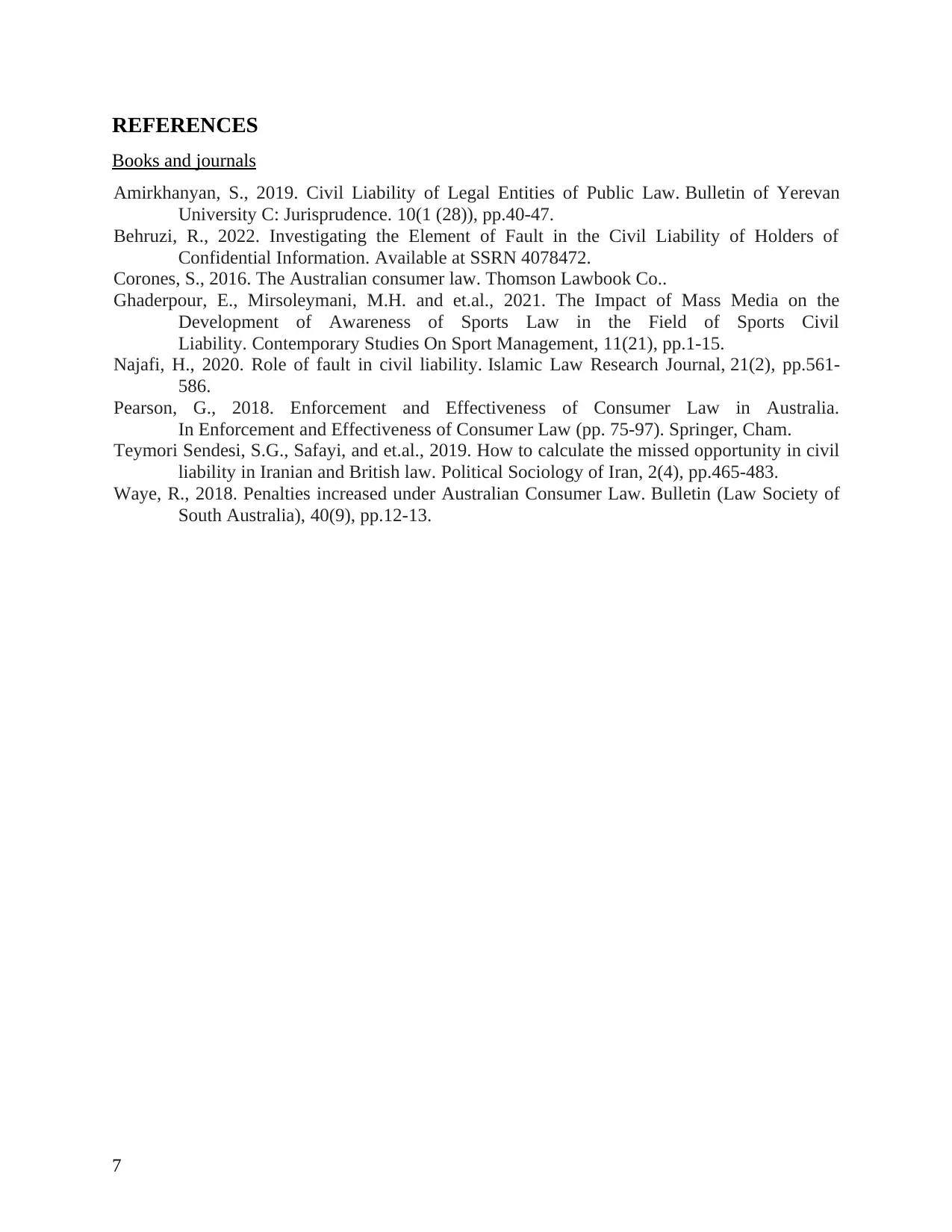
REFERENCES
Books and journals
Amirkhanyan, S., 2019. Civil Liability of Legal Entities of Public Law. Bulletin of Yerevan
University C: Jurisprudence. 10(1 (28)), pp.40-47.
Behruzi, R., 2022. Investigating the Element of Fault in the Civil Liability of Holders of
Confidential Information. Available at SSRN 4078472.
Corones, S., 2016. The Australian consumer law. Thomson Lawbook Co..
Ghaderpour, E., Mirsoleymani, M.H. and et.al., 2021. The Impact of Mass Media on the
Development of Awareness of Sports Law in the Field of Sports Civil
Liability. Contemporary Studies On Sport Management, 11(21), pp.1-15.
Najafi, H., 2020. Role of fault in civil liability. Islamic Law Research Journal, 21(2), pp.561-
586.
Pearson, G., 2018. Enforcement and Effectiveness of Consumer Law in Australia.
In Enforcement and Effectiveness of Consumer Law (pp. 75-97). Springer, Cham.
Teymori Sendesi, S.G., Safayi, and et.al., 2019. How to calculate the missed opportunity in civil
liability in Iranian and British law. Political Sociology of Iran, 2(4), pp.465-483.
Waye, R., 2018. Penalties increased under Australian Consumer Law. Bulletin (Law Society of
South Australia), 40(9), pp.12-13.
7
Books and journals
Amirkhanyan, S., 2019. Civil Liability of Legal Entities of Public Law. Bulletin of Yerevan
University C: Jurisprudence. 10(1 (28)), pp.40-47.
Behruzi, R., 2022. Investigating the Element of Fault in the Civil Liability of Holders of
Confidential Information. Available at SSRN 4078472.
Corones, S., 2016. The Australian consumer law. Thomson Lawbook Co..
Ghaderpour, E., Mirsoleymani, M.H. and et.al., 2021. The Impact of Mass Media on the
Development of Awareness of Sports Law in the Field of Sports Civil
Liability. Contemporary Studies On Sport Management, 11(21), pp.1-15.
Najafi, H., 2020. Role of fault in civil liability. Islamic Law Research Journal, 21(2), pp.561-
586.
Pearson, G., 2018. Enforcement and Effectiveness of Consumer Law in Australia.
In Enforcement and Effectiveness of Consumer Law (pp. 75-97). Springer, Cham.
Teymori Sendesi, S.G., Safayi, and et.al., 2019. How to calculate the missed opportunity in civil
liability in Iranian and British law. Political Sociology of Iran, 2(4), pp.465-483.
Waye, R., 2018. Penalties increased under Australian Consumer Law. Bulletin (Law Society of
South Australia), 40(9), pp.12-13.
7
1 out of 7
Related Documents
Your All-in-One AI-Powered Toolkit for Academic Success.
+13062052269
info@desklib.com
Available 24*7 on WhatsApp / Email
![[object Object]](/_next/static/media/star-bottom.7253800d.svg)
Unlock your academic potential
Copyright © 2020–2025 A2Z Services. All Rights Reserved. Developed and managed by ZUCOL.




